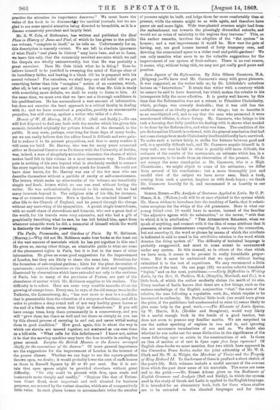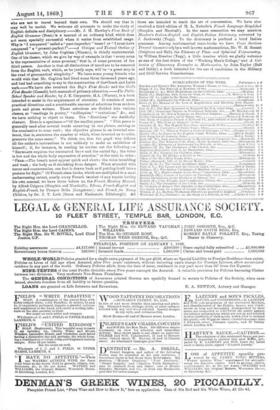Salem Booss.—The Ana ly sis of Sentences Applied to Latin. By 0.
P. Mason, B.A. (Walton.)—It will be at once objected to the system which Mr. Mason wishes to introduce into the teaching of Latin, that it substi- tutes scorpions for the whips of the old grammars. Here is what our young friend cetat. 10 would have to master, instead of the familiar " the adjective agrees with its substantive," or the newer, " with that to which it is in attribution." " Tits Arrenstrrrve RmialoN, when we speak of anything, and connect with it the idea of some attribute that it possesses, or some circumstance respecting it, assuming the connection, but not asserting it, the word or phrase by means of which the attribute is indicated is said to stand in the attributive relation to the word which denotes the thing spoken of." The difficulty of technical language is probably exaggerated, and must to some extent be encountered under any system. In this manual, as in others of the class whieh we have seen, it seems to be present in really formidable propor- tions. But it must be understood that we speak without having submitted it to the test of experience. We may recommend a little correction of the text. On one page (22) we notice cohortis translated "legion," and on the next, portabimur.—Early Difficulties in Writing Latin, by the Rev. G. Perkins, M.A. (Simpkin, Marshall, and Co.), is a little book, of which the author modestly claims the merit of its size. Every teacher of Latin knows that there are a few things, each as the various renderings of the English conjunction " that," the case of the relative, the case following a copulative verb, &e., which require to be hammered in endlessly. Mr. Perkins' little book (we would have given the price, if the publishers had condescended to state it) seems likely to give some help in the good work.—The Elements of Latin Syntax, by W. Harris, B.A. (Hodder and Stoughton), would very likely be a useful enough book in the hands of a good teacher, bat does not seem to possess any familiar merits. We are surprised to see the author speaking of supine in turn and tu, and ignoring the not uncommon terminations of sum and su. We doubt also whether he can make out the same distinction in the significances of the cases following super as exists in the constructions of sub. Is there an idea of motion or of rest in ligna super foco large rvonens? Of English class-books we must mention first two which have appeared in the Clarendon Press Series, under the joint editorship of Mr. W. G. Clark and Mr. W. A. Wright, the Merchant of Venice and the Tragedy of King Richard Li. To the former of these is prefixed a short sketch of the poet's life. Both volumes include a useful account of the sources from which the poet drew some of his materials. The notes are terse and to the point.—Mr. Ernest Adams gives us the Rudiments of English Grammar and Analysis (Bell and Daldy), in which the system used in the study of Greek and Latin is applied to the English language. It is intended for an elementary book, both for those whose studies are to be extended to the classical languages and for those who are not to travel beyond their own. We should say that it may well be useful. We welcome all attempts to make the study of English definite and disciplinary.—Mr. J. H. Hawley's First Book of English Grammar (Bean) is a manual of an ordinary kind, which does not seem specially successful when it varies from established usage. Why is "I conquered " called a " past-imperfect " tense? or " I must have conquered " a " present-perfect ?"--A Critique and Textual Outline of English Grammar, by John Coghlan (Nimmo), is chiefly controversial. One of his theses, which we give by way of example, is that "every noun is the representative of some pronoun," that is, of some pronoun of the third person. Another is that all distinctions of mood are to be removed from the English verb, which, as he justly says, will be "a great step in the road of grammatical simplicity." We have some young friends who would wish that Mr. Coghlan had lived some three thousand years ago, and had had something to say to the construction of the-Greek and Latin verb.—We have also received the Boy's First Reader and the Girl's First Reader (Cassell), both manuals of primary education.—The Public School Speaker and Reader, by J. E. Carpenter, M.A. (Warne), is a book intended to assist in the acquirement of elocution. It consists of some practical directions and a considerable amount of selections from modern poets and prose writers. These selections are divided into various classes, as "readings in poetry," "soliloquies," "recitations," &c., and we have nothing to object to them. The " directions " aro decidedly obscure. Here is a specimen—" Of the smaller pause." " This pause is generally used after several words occurring in one phrase, serving as the nominative to some verb ; the objective phrase in an inverted sen- tence, that is, sentences the number of which, when inverted as to order, preserve the same sense." We think, too, that the pupil who follows all the author's instructions is not unlikely to make an exhibition of himself ; if, for instance, in reading he carries out the following ;— "REPROACH requires the contracted brow and the curled lip ; the voice is low and the whole body expressive of aversion," or the next in order ; Fuss—The breath must appear quick and short ; the voice trembling and weak ; the body as if shrinking from danger. When attended with terror and consternation, one foot is drawn back as if putting itself into a posture for flight." Of French class-books, which are multiplied to a most embarrassing extent, nearly every French teacher of any repute having his own manual, wo have three before us, the French Mastery Manual, by Alfred Coignon (Simpkin and Marshall); Idioms, French-English and English-French, by Prosper Belin (Longmans); and French for Young Children, by Dr. J. T. Loth (Seton and Mackenzie, Edinburgh). All three are intended to teach the art of conversation. We have also received a third edition of M. L. Nottelle's French Language Simplified (Simpkin and Marshall). In the same connection we may mention Meadow's Italian-English and English-Italian Dictionary, corrected by J. Jazdowski (Tegg). To the dictionary is prefixed a brief Italian grammar. Among mathematical texts-books we have Conic Sections Treated Geometrically by a well-known mathematician, Mr. W. H. Besant (Deighton and Bell), the Elements of Plane and Spherical Trigonometry, by William Rossitor (Tegg), a little treatise which we gladly welcome as one of the first-fruits of the " Working Men's College," and A Col- lection of Elementary Examples in Mathematics, by John Taylor (Bell and Daldy), a book intended for the use of candidates in the Military and Civil Service Examinations.































 Previous page
Previous page